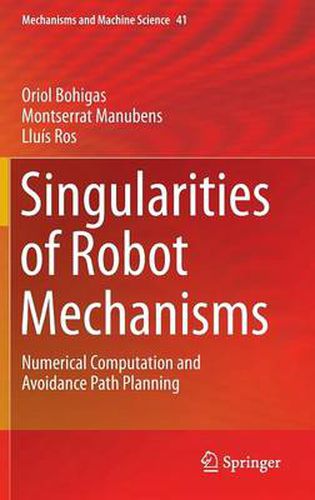Readings Newsletter
Become a Readings Member to make your shopping experience even easier.
Sign in or sign up for free!
You’re not far away from qualifying for FREE standard shipping within Australia
You’ve qualified for FREE standard shipping within Australia
The cart is loading…






This title is printed to order. This book may have been self-published. If so, we cannot guarantee the quality of the content. In the main most books will have gone through the editing process however some may not. We therefore suggest that you be aware of this before ordering this book. If in doubt check either the author or publisher’s details as we are unable to accept any returns unless they are faulty. Please contact us if you have any questions.
This book presents the singular configurations associated with a robot mechanism, together with robust methods for their computation, interpretation, and avoidance path planning. Having such methods is essential as singularities generally pose problems to the normal operation of a robot, but also determine the workspaces and motion impediments of its underlying mechanical structure. A distinctive feature of this volume is that the methods are applicable to nonredundant mechanisms of general architecture, defined by planar or spatial kinematic chains interconnected in an arbitrary way. Moreover, singularities are interpreted as silhouettes of the configuration space when seen from the input or output spaces. This leads to a powerful image that explains the consequences of traversing singular configurations, and all the rich information that can be extracted from them. The problems are solved by means of effective branch-and-prune and numerical continuation methods that are of independent interest in themselves. The theory can be put into practice as well: a companion web page gives open access to implementations of the algorithms and the corresponding input files. Using them, the reader can gain hands-on experience on the topic, or analyse new mechanisms beyond those examined in the text. Overall, the book contributes new tools for robot design, and constitutes a single reference source of knowledge that is otherwise dispersed in the literature.
$9.00 standard shipping within Australia
FREE standard shipping within Australia for orders over $100.00
Express & International shipping calculated at checkout
This title is printed to order. This book may have been self-published. If so, we cannot guarantee the quality of the content. In the main most books will have gone through the editing process however some may not. We therefore suggest that you be aware of this before ordering this book. If in doubt check either the author or publisher’s details as we are unable to accept any returns unless they are faulty. Please contact us if you have any questions.
This book presents the singular configurations associated with a robot mechanism, together with robust methods for their computation, interpretation, and avoidance path planning. Having such methods is essential as singularities generally pose problems to the normal operation of a robot, but also determine the workspaces and motion impediments of its underlying mechanical structure. A distinctive feature of this volume is that the methods are applicable to nonredundant mechanisms of general architecture, defined by planar or spatial kinematic chains interconnected in an arbitrary way. Moreover, singularities are interpreted as silhouettes of the configuration space when seen from the input or output spaces. This leads to a powerful image that explains the consequences of traversing singular configurations, and all the rich information that can be extracted from them. The problems are solved by means of effective branch-and-prune and numerical continuation methods that are of independent interest in themselves. The theory can be put into practice as well: a companion web page gives open access to implementations of the algorithms and the corresponding input files. Using them, the reader can gain hands-on experience on the topic, or analyse new mechanisms beyond those examined in the text. Overall, the book contributes new tools for robot design, and constitutes a single reference source of knowledge that is otherwise dispersed in the literature.